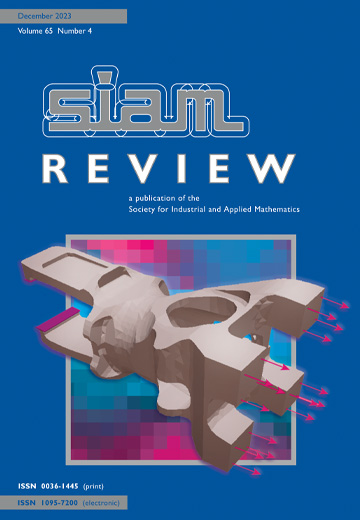Research Spotlights
IF 6.1
1区 数学
Q1 MATHEMATICS, APPLIED
引用次数: 0
Abstract
SIAM Review, Volume 66, Issue 2, Page 285-285, May 2024.The Gauss transform---convolution with a Gaussian in the continuous case and the sum of $N$ Gaussians at $M$ points in the discrete case---is ubiquitous in applied mathematics, from solving ordinary and partial differential equations to probability density estimation to science applications in astrophysics, image processing, quantum mechanics, and beyond. For the discrete case, the fast Gauss transform (FGT) enables the approximate calculation of the sum of $N$ Gaussians at $M$ points in order $N + M$ (instead of $NM$) operations by a fast summation strategy, which shares work between the sums at different points, similarly to the fast multipole method. In this issue's Research Spotlights section, “A New Version of the Adaptive Fast Gauss Transform for Discrete and Continuous Sources,” authors Leslie F. Greengard, Shidong Jiang, Manas Rachh, and Jun Wang present a new FGT technique that avoids the use of Hermite and local expansions. The new technique employs Fourier spectral approximations, which are accelerated by nonuniform fast Fourier transforms, and results in a considerably more efficient adaptive implementation. Adaptivity is especially vital for realizing the acceleration from a fast transform when points are highly nonuniform. The paper presents compelling illustrations and examples of the computational approach and the adaptive tree-based hierarchy employed. This hierarchy is used to resolve point distributions down to a refinement level determined by accuracy demands; this results in significantly better work per grid point than conventional FGT techniques. Consequently, the authors note that there are potential key benefits in parallelization of the proposed technique. In addition to the technique's clever composition of a broad variety of advanced computing paradigms and exploitation of mathematical structure to facilitate such fast transforms, the authors present several pathways of future research. For example, the analysis is readily accessible from dimensions larger than the illustrative examples illuminate, and univariate sum-of-exponentials structure also may be exploited; the computing techniques detailed by the authors could be tailored to such regimes. These future directions have broad application in scientific computing.
研究热点
SIAM Review》第 66 卷第 2 期第 285-285 页,2024 年 5 月。 高斯变换在应用数学中无处不在,从求解常微分方程和偏微分方程到概率密度估计,再到天体物理学、图像处理、量子力学等领域的科学应用,无不如此。对于离散情况,快速高斯变换(FGT)可以通过快速求和策略,以 $N+M$(而不是 $NM$)的运算顺序近似计算 $M$ 点上的 $N$ 高斯之和,该策略与快速多极法类似,在不同点的求和之间分担工作。在本期的研究热点 "针对离散和连续源的自适应快速高斯变换新版本 "部分,作者莱斯利-F-格林加德、蒋世东、马纳斯-拉赫和王军介绍了一种新的快速高斯变换技术,它避免了使用赫米特和局部展开。新技术采用傅立叶频谱近似,通过非均匀快速傅立叶变换加速,从而大大提高了自适应实施的效率。当点高度不均匀时,自适应对于实现快速变换的加速尤为重要。论文对计算方法和所采用的基于树的自适应层次结构进行了令人信服的说明和举例。这种层次结构用于解决点分布问题,其细化程度由精度要求决定;与传统的 FGT 技术相比,这使得每个网格点的工作量大大提高。因此,作者指出,拟议技术的并行化具有潜在的关键优势。除了该技术巧妙地结合了各种先进的计算范式,并利用数学结构促进快速变换之外,作者还提出了未来研究的几条途径。例如,该分析可以从比示例更大的维度进行,而且还可以利用单变量指数和结构;作者详细介绍的计算技术可以针对这种情况进行调整。这些未来方向在科学计算领域有着广泛的应用前景。
本文章由计算机程序翻译,如有差异,请以英文原文为准。
求助全文
约1分钟内获得全文
求助全文
来源期刊

SIAM Review
数学-应用数学
CiteScore
16.90
自引率
0.00%
发文量
50
期刊介绍:
Survey and Review feature papers that provide an integrative and current viewpoint on important topics in applied or computational mathematics and scientific computing. These papers aim to offer a comprehensive perspective on the subject matter.
Research Spotlights publish concise research papers in applied and computational mathematics that are of interest to a wide range of readers in SIAM Review. The papers in this section present innovative ideas that are clearly explained and motivated. They stand out from regular publications in specific SIAM journals due to their accessibility and potential for widespread and long-lasting influence.
 求助内容:
求助内容: 应助结果提醒方式:
应助结果提醒方式:


